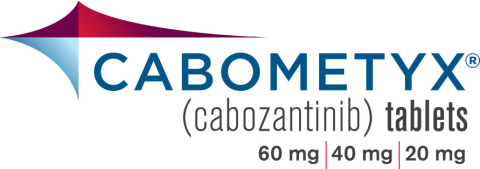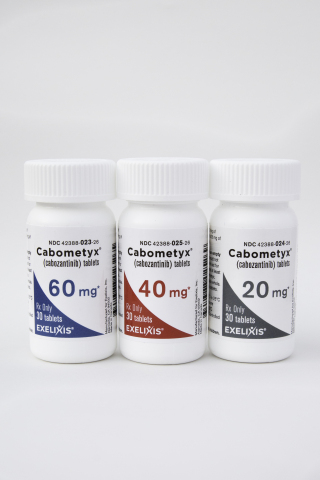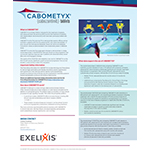ALAMEDA, Calif.--(BUSINESS WIRE)--Exelixis, Inc. (NASDAQ:EXEL) today announced that the U.S. Food and Drug Administration (FDA) approved CABOMETYX® (cabozantinib) tablets for patients with hepatocellular carcinoma (HCC) who have been previously treated with sorafenib. HCC is the most common form of liver cancer and the fastest-rising cause of cancer-related death in the U.S.1
“This new indication for CABOMETYX is an important treatment advance for patients with this aggressive form of liver cancer, a community in need of new therapeutic options,” said Michael M. Morrissey, Ph.D., President and Chief Executive Officer of Exelixis. “This approval is an important milestone as we continue to explore how CABOMETYX may benefit people with difficult-to-treat-cancers beyond renal cell carcinoma. We would like to thank the patients and clinicians who participated in CELESTIAL and to acknowledge the team at the FDA for their continued collaboration during the review of our application.”
The FDA’s approval of CABOMETYX was based on results from the CELESTIAL phase 3 pivotal trial of CABOMETYX for patients with advanced HCC who received prior sorafenib. CABOMETYX demonstrated a statistically significant and clinically meaningful improvement in overall survival (OS) versus placebo. On November 15, 2018, Exelixis’ partner Ipsen received approval from the European Commission for CABOMETYX tablets as a monotherapy for HCC in adults who have previously been treated with sorafenib.
“Patients with this form of advanced liver cancer have few treatment options, particularly once their disease progresses following treatment with sorafenib,” said Ghassan K. Abou-Alfa, M.D., Memorial Sloan Kettering Cancer Center, New York and lead investigator on CELESTIAL. “Physicians are eager for new options for these patients, and the results of the CELESTIAL trial demonstrate that CABOMETYX has the efficacy and safety profile to become an important new therapy in our efforts to slow disease progression and improve treatment outcomes.”
In the pivotal CELESTIAL trial, median OS was 10.2 months with cabozantinib versus 8.0 months with placebo (HR 0.76, 95 percent CI 0.63-0.92; p=0.0049). Median progression-free survival (PFS) was more than doubled, at 5.2 months with cabozantinib and 1.9 months with placebo (HR 0.44, 95 percent CI 0.36-0.52; p<0.0001). Objective response rates per RECIST 1.1 were 4 percent with cabozantinib and 0.4 percent with placebo (p=0.0086). Disease control (partial response or stable disease) was achieved by 64 percent of patients in the cabozantinib group compared with 33 percent of patients in the placebo group.
Adverse events in CELESTIAL were consistent with the known safety profile of cabozantinib. The most common (≥10 percent) grade 3 or 4 adverse events in the cabozantinib group compared to the placebo group were palmar-plantar erythrodysesthesia (17 percent vs. 0 percent), hypertension (16 percent vs. 2 percent), increased aspartate aminotransferase (12 percent vs. 7 percent), fatigue (10 percent vs. 4 percent) and diarrhea (10 percent vs. 2 percent). Treatment-related grade 5 adverse events occurred in six patients in the cabozantinib group (hepatic failure, esophagobronchial fistula, portal vein thrombosis, upper gastrointestinal hemorrhage, pulmonary embolism and hepatorenal syndrome) and in one patient in the placebo group (hepatic failure). Sixteen percent of patients in the cabozantinib arm and three percent of patients in the placebo arm discontinued treatment due to treatment-related adverse events.
“While we’ve seen some progress in the treatment of primary liver cancer in recent years, the patient community still needs new and better options,” said Andrea Wilson, President and Founder of Blue Faery: The Adrienne Wilson Liver Cancer Association. “The approval of CABOMETYX has been eagerly anticipated, making this an important day for patients diagnosed with this devastating disease.”
In December 2018, Exelixis and its partner Ipsen announced the initiation of COSMIC-312, a phase 3 pivotal trial of cabozantinib in combination with atezolizumab versus sorafenib in previously untreated advanced HCC. The trial will also explore single-agent activity of cabozantinib in the first-line setting. For more information about the trial, visit ClinicalTrials.gov.
Please see Important Safety Information below and full U.S. prescribing information at https://cabometyx.com/downloads/CABOMETYXUSPI.pdf.
About the CELESTIAL Study
CELESTIAL is a randomized, double-blind, placebo-controlled study of cabozantinib in patients with advanced HCC conducted at more than 100 sites globally in 19 countries. The trial was designed to enroll 760 patients with advanced HCC who received prior sorafenib and may have received up to two prior systemic cancer therapies for HCC and had adequate liver function. Enrollment of the trial was completed in September 2017. Patients were randomized 2:1 to receive 60 mg of cabozantinib once daily or placebo and were stratified based on etiology of the disease (hepatitis C, hepatitis B or other), geographic region (Asia versus other regions) and presence of extrahepatic spread and/or macrovascular invasion (yes or no). No cross-over was allowed between the study arms during the blinded treatment phase of the trial. The primary endpoint for the trial is OS, and secondary endpoints include objective response rate and PFS. Exploratory endpoints include patient-reported outcomes, biomarkers and safety.
In October 2017, Exelixis announced that the independent data monitoring committee for the CELESTIAL study recommended that the trial be stopped for efficacy following review at the second planned interim analysis, with cabozantinib providing a statistically significant and clinically meaningful improvement in OS compared with placebo in patients with previously treated advanced HCC. The data, originally presented at the 2018 American Society of Clinical Oncology’s Gastrointestinal Cancers Symposium (ASCO-GI) in January 2018, were published in The New England Journal of Medicine in July 2018.2
About HCC
Liver cancer is a leading cause of cancer death worldwide, accounting for more than 700,000 deaths and 800,000 new cases each year.3 In the U.S., the incidence of liver cancer has more than tripled since 1980.4 HCC is the most common form of liver cancer, making up about three-fourths of the estimated nearly 42,000 new cases in the U.S. in 2019.4 HCC is the fastest-rising cause of cancer-related death in the U.S.1 Without treatment, patients with advanced HCC usually survive less than 6 months.5
About CABOMETYX® (cabozantinib)
CABOMETYX tablets are approved in the United States for the treatment of patients with advanced renal cell carcinoma (RCC) and for the treatment of patients with HCC who have been previously treated with sorafenib. CABOMETYX tablets are also approved in: the European Union, Norway, Iceland, Australia, Switzerland, South Korea, Hong Kong, Ukraine, Canada, Taiwan, Jordan, and Macau for the treatment of advanced RCC in adults who have received prior VEGF-targeted therapy; in the European Union, Norway, Iceland, Australia, and Jordan for previously untreated intermediate- or poor-risk advanced RCC; in Canada for adult patients with advanced RCC who have received prior VEGF targeted therapy; in advanced or metastatic RCC in Brazil; and in the European Union, Norway and Iceland for HCC in adults who have previously been treated with sorafenib. In 2016, Exelixis granted Ipsen exclusive rights for the commercialization and further clinical development of cabozantinib outside of the United States and Japan. In 2017, Exelixis granted exclusive rights to Takeda Pharmaceutical Company Limited for the commercialization and further clinical development of cabozantinib for all future indications in Japan.
U.S. Important Safety Information
- Hemorrhage: Severe and fatal hemorrhages occurred with CABOMETYX. The incidence of Grade 3 to 5 hemorrhagic events was 5% in CABOMETYX patients. Discontinue CABOMETYX for Grade 3 or 4 hemorrhage. Do not administer CABOMETYX to patients who have a recent history of hemorrhage, including hemoptysis, hematemesis, or melena.
- Perforations and Fistulas: GastrointestinaI (GI) perforations, including fatal cases, occurred in 1% of CABOMETYX patients. Fistulas, including fatal cases, occurred in 1% of CABOMETYX patients. Monitor patients for signs and symptoms of perforations and fistulas, including abscess and sepsis. Discontinue CABOMETYX in patients who experience a fistula that cannot be appropriately managed or a GI perforation.
- Thrombotic Events: CABOMETYX increased the risk of thrombotic events. Venous thromboembolism occurred in 7% (including 4% pulmonary embolism) and arterial thromboembolism in 2% of CABOMETYX patients. Fatal thrombotic events occurred in CABOMETYX patients. Discontinue CABOMETYX in patients who develop an acute myocardial infarction or serious arterial or venous thromboembolic event requiring medical intervention.
- Hypertension and Hypertensive Crisis: CABOMETYX can cause hypertension, including hypertensive crisis. Hypertension occurred in 36% (17% Grade 3 and <1% Grade 4) of CABOMETYX patients. Do not initiate CABOMETYX in patients with uncontrolled hypertension. Monitor blood pressure regularly during CABOMETYX treatment. Withhold CABOMETYX for hypertension that is not adequately controlled with medical management; when controlled, resume at a reduced dose. Discontinue CABOMETYX for severe hypertension that cannot be controlled with anti-hypertensive therapy or for hypertensive crisis.
- Diarrhea: Diarrhea occurred in 63% of CABOMETYX patients. Grade 3 diarrhea occurred in 11% of CABOMETYX patients. Withhold CABOMETYX until improvement to Grade 1 and resume at a reduced dose for intolerable Grade 2 diarrhea, Grade 3 diarrhea that cannot be managed with standard antidiarrheal treatments, or Grade 4 diarrhea.
- Palmar-Plantar Erythrodysesthesia (PPE): PPE occurred in 44% of CABOMETYX patients. Grade 3 PPE occurred in 13% of CABOMETYX patients. Withhold CABOMETYX until improvement to Grade 1 and resume at a reduced dose for intolerable Grade 2 PPE or Grade 3 PPE.
- Proteinuria: Proteinuria occurred in 7% of CABOMETYX patients. Monitor urine protein regularly during CABOMETYX treatment. Discontinue CABOMETYX in patients who develop nephrotic syndrome.
- Osteonecrosis of the Jaw (ONJ): ONJ occurred in <1% of CABOMETYX patients. ONJ can manifest as jaw pain, osteomyelitis, osteitis, bone erosion, tooth or periodontal infection, toothache, gingival ulceration or erosion, persistent jaw pain, or slow healing of the mouth or jaw after dental surgery. Perform an oral examination prior to CABOMETYX initiation and periodically during treatment. Advise patients regarding good oral hygiene practices. Withhold CABOMETYX for at least 28 days prior to scheduled dental surgery or invasive dental procedures. Withhold CABOMETYX for development of ONJ until complete resolution.
- Wound Complications: Wound complications were reported with CABOMETYX. Stop CABOMETYX at least 28 days prior to scheduled surgery. Resume CABOMETYX after surgery based on clinical judgment of adequate wound healing. Withhold CABOMETYX in patients with dehiscence or wound healing complications requiring medical intervention.
- Reversible Posterior Leukoencephalopathy Syndrome (RPLS): RPLS, a syndrome of subcortical vasogenic edema diagnosed by characteristic finding on MRI, can occur with CABOMETYX. Evaluate for RPLS in patients presenting with seizures, headache, visual disturbances, confusion, or altered mental function. Discontinue CABOMETYX in patients who develop RPLS.
- Embryo-Fetal Toxicity: CABOMETYX can cause fetal harm. Advise pregnant women and females of reproductive potential of the potential risk to a fetus. Verify the pregnancy status of females of reproductive potential prior to initiating CABOMETYX and advise them to use effective contraception during treatment and for 4 months after the last dose.
- Adverse Reactions: The most commonly reported (≥25%) adverse reactions are: diarrhea, fatigue, decreased appetite, PPE, nausea, hypertension, and vomiting.
- Strong CYP3A4 Inhibitors: If coadministration with strong CYP3A4 inhibitors cannot be avoided, reduce the CABOMETYX dosage. Avoid grapefruit or grapefruit juice.
- Strong CYP3A4 Inducers: If coadministration with strong CYP3A4 inducers cannot be avoided, increase the CABOMETYX dosage. Avoid St. John’s wort.
- Lactation: Advise women not to breastfeed during CABOMETYX treatment and for 4 months after the final dose.
- Hepatic Impairment: In patients with moderate hepatic impairment, reduce the CABOMETYX dosage. CABOMETYX is not recommended for use in patients with severe hepatic impairment.
Please see accompanying full Prescribing Information https://cabometyx.com/downloads/CABOMETYXUSPI.pdf.
About Exelixis
Founded in 1994, Exelixis, Inc. (Nasdaq: EXEL) is a commercially successful, oncology-focused biotechnology company that strives to accelerate the discovery, development and commercialization of new medicines for difficult-to-treat cancers. Following early work in model genetic systems, we established a broad drug discovery and development platform that has served as the foundation for our continued efforts to bring new cancer therapies to patients in need. We discovered our three commercially available products, CABOMETYX® (cabozantinib), COMETRIQ® (cabozantinib) and COTELLIC® (cobimetinib), and have entered into partnerships with leading pharmaceutical companies to bring these important medicines to patients worldwide. Supported by revenues from our marketed products and collaborations, we are committed to prudently reinvesting in our business to maximize the potential of our pipeline. We are supplementing our existing therapeutic assets with targeted business development activities and internal drug discovery – all to deliver the next generation of Exelixis medicines and help patients recover stronger and live longer. Exelixis is a member of Standard & Poor’s (S&P) MidCap 400 index, which measures the performance of profitable mid-sized companies. For more information about Exelixis, please visit www.exelixis.com, follow @ExelixisInc on Twitter or like Exelixis, Inc. on Facebook.
Exelixis Forward-Looking Statements
This press release contains forward-looking statements, including, without limitation, statements related to: Exelixis’ preparedness to fully support the indication of previously treated advanced HCC immediately; Exelixis’ plans to continue to explore how CABOMETYX may benefit people with difficult-to-treat cancers beyond RCC; the potential for CABOMETYX to become an important new therapy that slows disease progression and improves treatment outcomes for patients with HCC who have progressed following treatment with sorafenib; and Exelixis’ plans to reinvest in its business to maximize the potential of the company’s pipeline, including through targeted business development activities and internal drug discovery. Any statements that refer to expectations, projections or other characterizations of future events or circumstances are forward-looking statements and are based upon Exelixis’ current plans, assumptions, beliefs, expectations, estimates and projections. Forward-looking statements involve risks and uncertainties. Actual results and the timing of events could differ materially from those anticipated in the forward-looking statements as a result of these risks and uncertainties, which include, without limitation: the degree of market acceptance of CABOMETYX and the availability of sufficient coverage and adequate reimbursement for this product; the strength of CABOMETYX sales efforts, marketing, medical affairs and distribution support; the effectiveness of CABOMETYX in comparison to competing products; uncertainties inherent in the product development process; the level of costs associated with Exelixis’ cabozantinib development activities; Exelixis’ continuing compliance with applicable legal and regulatory requirements; Exelixis’ ability to protect its intellectual property rights; Exelixis’ dependence on third-party vendors for the manufacture and supply of cabozantinib; market competition, including the potential for competitors to obtain approval for generic versions of CABOMETYX; changes in economic and business conditions; and other factors affecting Exelixis’ ability to commercialize CABOMETYX and expand the cabozantinib development program discussed under the caption “Risk Factors” in Exelixis’ Quarterly Report on Form 10-Q filed with the Securities and Exchange Commission (SEC) on November 1, 2018, and in Exelixis’ future filings with the SEC. All forward-looking statements in this press release are based on information available to Exelixis as of the date of this press release, and Exelixis undertakes no obligation to update or revise any forward-looking statements contained herein.
Exelixis, the Exelixis logo, CABOMETYX, COMETRIQ and COTELLIC are registered U.S. trademarks.
# # #
| 1 | Mittal S, El-Serag HB. Epidemiology of HCC: Consider the Population. J Clin Gastroenterol. 2013. 47:S2-S6. | |
| 2 | Abou-Alfa, G, Meyer T, Cheng AL, et al. Cabozantinib in patients with advanced and progressing hepatocellular carcinoma. N Engl J Med. 2018. 379:54-63. | |
| 3 |
International Agency for Research on Cancer. GLOBOCAN 2018. Liver Fact Sheet. Available at: http://gco.iarc.fr/today/data/factsheets/cancers/11-Liver-fact-sheet.pdf. Accessed January 2019. |
|
| 4 |
American Cancer Society: Cancer Facts and Figures 2019. Available at: https://www.cancer.org/content/dam/cancer-org/research/cancer-facts-and-statistics/annual-cancer-facts-and-figures/2019/cancer-facts-and-figures-2019.pdf. Accessed January 2019. |
|
| 5 | Weledji E, Orock G, Ngowe M, NsaghaD. How grim is hepatocellular carcinoma? Ann Med Surg. 2014. 3:71-76. | |








